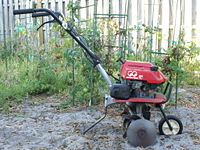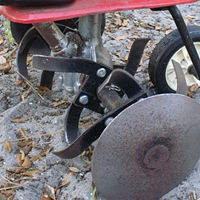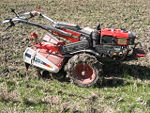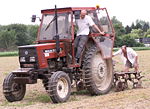Difference between revisions of "Rotary tiller" - New World Encyclopedia
(→Origin) |
(→Origin) |
||
| Line 7: | Line 7: | ||
The powered rotary hoe was invented by Arthur Clifford Howard who, in 1912, began experimenting with rotary tillage on his father's farm at [[Gilgandra, New South Wales]], [[Australia]]. Initially using his father's steam tractor engine as a power source, he found that ground could be mechanically tilled without soil-packing occurring, as was the case with normal ploughing. His earliest designs threw the tilled soil sideways, until he improved his invention by designing an L-shaped blade mounted on widely spaced flanges fixed to a small-diameter rotor. With fellow apprentice Everard McCleary, he established a company to make his machine, but plans were interrupted by [[World War I]]. In 1919 Howard returned to Australia and resumed his design work, patenting a design with 5 rotary hoe cultivator blades and an internal combustion engine, in 1920.<ref name="Langmore">Langmore, Diane. 2006. [http://www.adb.online.anu.edu.au/biogs/A090376b.htm Howard, Arthur Clifford (1893 - 1971)]. ''Australian Dictionary of Biography'', online edition. Australian National University. Retrieved November 19, 2008.</ref> | The powered rotary hoe was invented by Arthur Clifford Howard who, in 1912, began experimenting with rotary tillage on his father's farm at [[Gilgandra, New South Wales]], [[Australia]]. Initially using his father's steam tractor engine as a power source, he found that ground could be mechanically tilled without soil-packing occurring, as was the case with normal ploughing. His earliest designs threw the tilled soil sideways, until he improved his invention by designing an L-shaped blade mounted on widely spaced flanges fixed to a small-diameter rotor. With fellow apprentice Everard McCleary, he established a company to make his machine, but plans were interrupted by [[World War I]]. In 1919 Howard returned to Australia and resumed his design work, patenting a design with 5 rotary hoe cultivator blades and an internal combustion engine, in 1920.<ref name="Langmore">Langmore, Diane. 2006. [http://www.adb.online.anu.edu.au/biogs/A090376b.htm Howard, Arthur Clifford (1893 - 1971)]. ''Australian Dictionary of Biography'', online edition. Australian National University. Retrieved November 19, 2008.</ref> | ||
| − | In March 1922 Howard formed the company Austral Auto Cultivators Pty Ltd, which later became known as Howard Auto Cultivators. It was based in [[Northmead, New South Wales|Northmead]], a suburb of [[Sydney]], from 1927.<ref name="Langmore"/> Finding it increasingly difficult to meet a growing worldwide demand, Howard traveled to the [[United Kingdom]], founding the company Rotary Hoes Ltd in [[East Horndon]], Essex, in July 1938.<ref>[http://www.donaldantiquerototillers.com/British.html The Howard Rotavator]. Retrieved November 19, 2008.</ref> Branches of this new company subsequently opened in the United States of America, South Africa, Germany, France, Italy, Spain, Brazil, Malaysia, Australia and New Zealand. It later became the holding company for Howard Rotavator Co. Ltd.<ref name="Langmore"/> The Howard Group of companies was acquired by the [[Denmark|Danish]] Thrige Agro Group in 1985, and in December 2000 the Howard Group became a member of Kongskilde Industries of [[Sorø|Soroe]], [[Denmark]].<ref> | + | In March 1922 Howard formed the company Austral Auto Cultivators Pty Ltd, which later became known as Howard Auto Cultivators. It was based in [[Northmead, New South Wales|Northmead]], a suburb of [[Sydney]], from 1927.<ref name="Langmore"/> Finding it increasingly difficult to meet a growing worldwide demand, Howard traveled to the [[United Kingdom]], founding the company Rotary Hoes Ltd in [[East Horndon]], Essex, in July 1938.<ref>[http://www.donaldantiquerototillers.com/British.html The Howard Rotavator]. Retrieved November 19, 2008.</ref> Branches of this new company subsequently opened in the United States of America, South Africa, Germany, France, Italy, Spain, Brazil, Malaysia, Australia and New Zealand. It later became the holding company for Howard Rotavator Co. Ltd.<ref name="Langmore"/> The Howard Group of companies was acquired by the [[Denmark|Danish]] Thrige Agro Group in 1985, and in December 2000 the Howard Group became a member of Kongskilde Industries of [[Sorø|Soroe]], [[Denmark]].<ref>[http://www.agmachine.com/ammd44el.htm Machinery Manufacturers - Secondary Tillage]. Worldwide Agricultural Machinery and Equipment Directory. Retrieved November 19, 2008.</ref> |
| − | |||
| − | |||
| − | |||
| − | |||
| − | |||
| − | |||
| − | |||
| − | |||
| − | |||
==Self-propelled small rotary tillers== | ==Self-propelled small rotary tillers== | ||
Revision as of 18:27, 19 November 2008
A rotary tiller, also known as a rototiller, rotavator, rotary hoe, power tiller, or rotary plow (rotary plough in British English), is a motorized cultivator that works the soil by means of rotating tines or blades. Rotary tillers are either self propelled or drawn as an attachment behind either a two-wheel tractor or four-wheel tractor. For two-wheel tractors they are rigidly fixed and powered via couplings to the tractors' transmission. For four-wheel tractors they are attached by means of a three-point hitch and driven by a Power Take-Off (PTO).
Origin
The powered rotary hoe was invented by Arthur Clifford Howard who, in 1912, began experimenting with rotary tillage on his father's farm at Gilgandra, New South Wales, Australia. Initially using his father's steam tractor engine as a power source, he found that ground could be mechanically tilled without soil-packing occurring, as was the case with normal ploughing. His earliest designs threw the tilled soil sideways, until he improved his invention by designing an L-shaped blade mounted on widely spaced flanges fixed to a small-diameter rotor. With fellow apprentice Everard McCleary, he established a company to make his machine, but plans were interrupted by World War I. In 1919 Howard returned to Australia and resumed his design work, patenting a design with 5 rotary hoe cultivator blades and an internal combustion engine, in 1920.[1]
In March 1922 Howard formed the company Austral Auto Cultivators Pty Ltd, which later became known as Howard Auto Cultivators. It was based in Northmead, a suburb of Sydney, from 1927.[1] Finding it increasingly difficult to meet a growing worldwide demand, Howard traveled to the United Kingdom, founding the company Rotary Hoes Ltd in East Horndon, Essex, in July 1938.[2] Branches of this new company subsequently opened in the United States of America, South Africa, Germany, France, Italy, Spain, Brazil, Malaysia, Australia and New Zealand. It later became the holding company for Howard Rotavator Co. Ltd.[1] The Howard Group of companies was acquired by the Danish Thrige Agro Group in 1985, and in December 2000 the Howard Group became a member of Kongskilde Industries of Soroe, Denmark.[3]
Self-propelled small rotary tillers
A small rotary hoe for domestic gardens was known by the trademark Rototiller and another, made by the Howard Group who produced a range of rotary tillers, was known as the Rotavator.
The Rototiller
Rotary tillers are popular with home gardeners who want large vegetable gardens. The garden may be tilled a few times before planting each crop. Rotary tillers may be rented from tool rental centers for single-use applications, such as when planting grass.
The small rototiller is typically propelled forward (via 1-5 horsepower petrol engine or .8 - 3.5 kilowatts) by the rotating tines and do not have powered wheels, though they may have small transport/level control wheel(s). To keep the machine from moving forward too fast, an adjustable tine is usually fixed just behind the blades so that through friction with deeper un-tilled soil, it acts as a brake, slowing the machine and allowing it to pulverize the soils. The slower a rototiller moves forward, the more soil tilth can be obtained. The operator can control the amount of friction/braking action by raising and lowering the handlebars of the tiller. Rototillers do not have a reverse as such backwards movement towards the operator could cause serious injury. While operating the rototiller can be pulled backwards to go over areas that were not pulverized enough, but care must be taken to ensure that the operator does not stumble and pull the rototiller on top of himself. Rototilling is much faster than manual tilling, but notoriously difficult to handle and exhausting work, especially in the heavier and higher horse power models. If the rototiller's blades catch on unseen sub-surface objects, such as tree roots and buried garbage, it can cause the rototiller to abruptly and violently move in any direction.
The Rotavator
Unlike the Rototiller, the self propelled Howard Rotavator is equipped with a gearbox and driven forward, or held back, by its wheels. The gearbox enables the forward speed to be adjusted while the rotational speed of the tines remains constant which enables the operator to easily regulate the extent to which soil is engaged. For a two-wheel tractor rotavator this greatly reduces the workload of the operator as compared to a rototiller. These rotavators are generally more heavy duty, come in higher horsepower (4-18 horsepower or 3-13 kilowatts) with either petrol or diesel engines and can cover much more area per hour.
The trademarked word "Rotavator" is one of the longest palindromes in the English language.
Agricultural rotary tillers
Two-wheel tractor The higher horsepower "riding" rotavators cross out of the home garden category into farming category especially in Asia, Africa and South America, capable of preparing 1 hectare of land in 8 - 10 hours. These are also known as power tillers, walking tractors or two-wheel tractors. Years ago they were considered only useful for rice growing areas, where they were fitted with steel cage-wheels for traction, but now the same are being used in both wetland and dryland farming all over the world. Compact, powerful and most importantly inexpensive, these agricultural rotary tillers are providing alternatives to four-wheel tractors and in the small farmers fields in developing countries are more economical than four-wheel tractors.
Four-wheel tractor Four-wheel tractor-drawn rotary tillers are attached to a three point linkage and are driven by a power take off shaft. Generally considered a secondary tillage implement they can and are commonly used for primary tillage. They also can also be used for inter-cultivation between and for cultivation between rows of vines, etc.
Other uses
- Rotary tillers can also be used for road-making.
- Beginning in the 1970s or 1980s, hand operated rototillers were modified to clean the exterior of oilfield pipes. These pipes, either new or used, and in sizes that are just over 2 inches in diameter to 30 inches or larger, were used in the exploration, drilling and production of oil wells. These modified tools replaced cleaning using hand tools, and were ultimately supplanted by machinery that cleaned entire pipe lengths within a few years.The modification replaced the tines with wire brushes. The tool was used by a man walking the length of a pipe (typically 30 or 40 feet), which was rotated.
See also
Notes
- ↑ 1.0 1.1 1.2 Langmore, Diane. 2006. Howard, Arthur Clifford (1893 - 1971). Australian Dictionary of Biography, online edition. Australian National University. Retrieved November 19, 2008.
- ↑ The Howard Rotavator. Retrieved November 19, 2008.
- ↑ Machinery Manufacturers - Secondary Tillage. Worldwide Agricultural Machinery and Equipment Directory. Retrieved November 19, 2008.
ReferencesISBN links support NWE through referral fees
- Baker, Jerry. 1985. Jerry Baker's Fast, Easy Vegetable Garden. New York: Plume. ISBN 0452281040
- Intertec Publishing Corporation. 1989. Rotary Tiller Service Manual, 3rd ed. Overland Park, Kan: Intertec Pub. Corp. ISBN 0872883531
- Rogers, Marilyn, and Kathleen Bond Borie. 2004. Yard & Garden Owners Manual: Your Complete Guide to the Care and Upkeep of Everything Outdoors. Des Moines, IA: Better Homes and Gardens Books. ISBN 0696217600
External links
- Agricultural Engineering - Power Tillers from India's Apex Bank for Rural Development
- The Howard Rotavator and Rotary Hoe
- Selecting a Power Tiller from Virginia Cooperative Extension
- Database covering all makes and models of farm tractors
- Yagmur Corporation - One of the biggest Rotary Tiller manufacturer.
| ||||
|---|---|---|---|---|
|
Cutting tools - Adze | Axe | Bolt cutters | Ceramic tile cutter | Chainsaw | Machete | Kukri | Saw | Knife | Broach | Endmill | Reamer | Drill bit | Tool bit | Countersink | Front teeth | Milling cutter | Razor blade |Scalpel | Scissors | Blade | Fingernail | Switchblade | Water jet cutter
Garden tools - Cultivator | Garden fork | Hedge trimmer | Hoe | Hori hori | Lawnmower | Lawn aerator | Leaf blower | Leaf sweeper | Loppers | Mattock | McLeod | Mini-tractor | Pitchfork | Plow | Pruning shears | Pulaski | Rake (tool) | Secateurs | Spade | Sprinkler | String trimmer | Trimmer
Hand tools - Brace | Chisel | Hammer | Screwdriver | Handsaw | Pliers | Torque wrench | Clamp | Level | Sponge
Power tools - Band saw | Belt sander | Chainsaw | Circular saw | Concrete saw | Crusher | Diamond blade | Disc sander | Drill | Impact wrench | Grinder | Heat gun | Jointer | Jigsaw | Lathe | Radial arm saw | Random orbital sander | Rotary tool | Sander | Table saw | Thickness planer | Wood router
See also - Antique tools | Diamond tools
| ||||
Credits
New World Encyclopedia writers and editors rewrote and completed the Wikipedia article in accordance with New World Encyclopedia standards. This article abides by terms of the Creative Commons CC-by-sa 3.0 License (CC-by-sa), which may be used and disseminated with proper attribution. Credit is due under the terms of this license that can reference both the New World Encyclopedia contributors and the selfless volunteer contributors of the Wikimedia Foundation. To cite this article click here for a list of acceptable citing formats.The history of earlier contributions by wikipedians is accessible to researchers here:
The history of this article since it was imported to New World Encyclopedia:
Note: Some restrictions may apply to use of individual images which are separately licensed.



